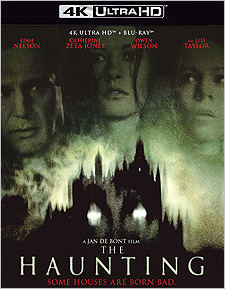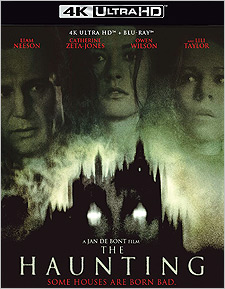Haunting, The (1999) (4K UHD Review)

Director
Jan de BontRelease Date(s)
1999 (May 30, 2023)Studio(s)
DreamWorks/Paramount (Shout!/Scream Factory)- Film/Program Grade: C+
- Video Grade: A+
- Audio Grade: A
- Extras Grade: C
Review
[Editor’s Note: The majority of this review was originally written by Dennis Seuling. The video and parts of the audio portion are written by Tim Salmons.]
The original 1963 British feature The Haunting, based on Shirley Jackson’s novel The Haunting of Hill House, ranks among the best of the haunted house genre. It’s puzzling when filmmakers choose to remake classic originals. In this case, an attempt was made to update The Haunting for 1999 audiences with modern special effects and an impressive cast of name actors.
Eleanor (Lili Taylor) is an insomniac who has lived with her invalid mother and taken sole care of her for many years until her death a few months earlier. Eleanor’s sister and brother-in-law intend to sell their mother’s house, leaving Eleanor homeless, with few financial resources and no skills valued in the job market. When her attention is drawn to a newspaper ad offering $900 to participate in a sleep study, she applies and is selected.
The study is to take place at a massive mansion named Hill House. Eleanor is the first of the study subjects to arrive. She’s shown around the magnificent house by its only other occupant, the solemn housekeeper Mrs. Dudley (Marian Seldes). Eventually the other subjects, Theo (Catherine Zeta-Jones) and Luke (Owen Wilson), arrive, as well as the professor conducting the study, Dr. David Marrow (Liam Neeson). Soon after the guests settle in, unexplained noises and events begin. Over the next few days, these become increasingly dangerous, and Eleanor appears to be the main target. Afflicted with frightening visions, she wonders whether they’re real or if she’s going insane.
The cast is first-tier, with Neeson—before his days as an action-film avenger—convincing as a researcher who may be interested in something other than sleep disorders. Zeta-Jones’ Theo is a fashionable New Yorker with a flair for trendy clothes and lifestyles. She indicates that she’s bisexual but little is made of this point. Wilson is the down-to-earth, good ol’ boy who’s skeptical of the strange goings-on and Eleanor’s visions, which no one else shares. He can’t believe the house has a mind of its own.
Taylor is well cast as a withdrawn, somewhat shy, and eventually terrified woman who must learn why she’s been singled out. Her gradual change from unsuspecting victim to damsel in distress is paced well, and she elicits sympathy in part because she avoids doing the kinds of stupid things that drive horror fans crazy. Intelligent and reasonably cautious, she feels way out of her depth as she faces malevolent supernatural forces. Taylor conveys the vulnerability, confusion, and fear required by David Self’s script.
The weaknesses of the film are its overuse of CGI, a meandering screenplay, and a too-lengthy running time. The CGI effects are impressive, but are more technical wonders than sources of terror. Director Jan de Bont (Speed) never creates the kind of heart-stopping atmosphere that’s so essential to a film like this. He uses huge set pieces, including a collapsing spiral staircase, a rotating floor and spinning mirrors, ceiling posts that shoot down to pin someone to a bed, a snapping dulcimer wire, gargoyle statues that come to life, wooden carvings that moan and shed tears, and a fireplace with a killer damper, but we marvel at the staging of these scenes instead of feeling scared.
The original film practically dripped with atmosphere and succeeded mostly because of its taut script and first-rate performances. De Bont misses opportunities throughout. Some of the best scenes are those in which Eleanor walks slowly through endless hallways or when she’s alone and noises are heard but nothing is seen. These are the moments that create the requisite chill. De Bont seems to have felt a reliance on razzle-dazzle to hold the audience’s attention.
The Haunting was shot by cinematographer Karl Walter Lindenlaub on 35 mm film using Beaumont VistaVision and Panavision Panaflex cameras with Panavision Primo, Panaivision C-Series, Panavision E-Series, and Nikon lenses. Everything was finished photochemically at the aspect ratio of 2.39:1. Scream Factory presents the film on Ultra HD for the first time with a presentation utilizing Paramount’s 2020 4K Digital Intermediate, (used for their Paramount Presents Blu-ray release), which was prepared from a new scan of the original camera negative, and now graded for High Dynamic Range (HDR10 and Dolby Vision options are included). Whatever qualms one may have about the film itself, its UHD presentation is stellar... dare I say, demo-worthy. Detail is off the charts with a fine sheen of grain and an extremely healthy bitrate, soaking up the gorgeous production design in and around Hill House. The HDR passes widen the gamut considerably, boosting contrast and allowing for deep, inky blacks and elevating the minutia in the shadows. The color palette also benefits, offering newfound clarity and detail previously hidden in lesser presentations. (Even the CGI seems less intrusive.) Everything appears stable and clean front to back. It’s as flawless a picture as you’re going to find in 2160p.
Audio is included in English 5.1 and a new 2.0 down-mix, both DTS-HD Master Audio tracks with optional subtitles in English SDH. The Paramount Presents Blu-ray also offered the following options: English Audio Descriptive and German, French, and Japanese 5.1 Dolby Digital with optional subtitles in German, French, and Japanese. Dialogue is sharp throughout and sound mixing is quite effective with speech, ambient sound, and music well balanced. Jerry Goldsmith’s score does little to enhance the terror and is often merely space filler to accompany drawn-out scenes. Sound effects play an important role, contributing to a sense of foreboding. Massive doors opening and closing and insistent banging are the first manifestations that signal the house is beyond ordinary. As Dr. Marrow tries to save Eleanor from a precarious spot, he has to navigate a dangling, deteriorating spiral staircase which creaks as bolts undo themselves and parts of the staircase fall to the ground. Intermittent thumps in the night, poundings, and creaky sounds pervade the house and comprise its “voice.”
The Haunting on 4K Ultra HD sits in a black amaray case alongside a 1080p Blu-ray and an insert featuring artwork from one of the film’s theatrical posters. The following extras are included on the Blu-ray only, which are identical to those found on the Paramount Presents Blu-ray:
- Filmmaker Focus: Jan de Bont (HD – 9:14)
- Behind-the-Scenes Featurette (SD – 27:12)
- Teaser Trailer (SD – 1:16)
- Theatrical Trailer (HD – 2:23)
Filmmaker Focus: Jan de Bont – Production discussions for The Haunting started before the rights were secured. Because the filmmakers weren’t permitted to use any scenes or dialogue from the book, the script writer had to rethink the story. It was vital to believe in the sensitivity to her environment and the vulnerability of the actor cast as Eleanor. Lili Taylor fit the bill. In terms of the sets, “everything was bigger than life.” The sets of the interior of Hill House and its greenhouse were built especially for the film. They were so enormous that no studio would accommodate them, so they were constructed where Howard Hughes built the Spruce Goose. The mirror room presented reflections on reflections on reflections because of the rotating stage and revolving mirrors. Initially, Steven Spielberg was preparing The Haunting while de Bont was preparing Minority Report. Because Minority Report wasn’t ready to shoot, the two directors switched movies. De Bont reflects on the many special effects used in the film, which rendered it more of a horror film than a drama like the original.
Behind-the-Scenes Featurette – Catherine Zeta-Jones introduces and narrates this making-of mini-documentary. Clips from the film are shown along with interview excerpts from director Jan de Bont, producer Susan Arnold, and actors Liam Neeson, Lili Taylor, and Owen Wilson, who speak briefly about their characters. Wilson refers to the massive sets as “awe inspiring” with their blend of Victorian, Gothic, and Renaissance architecture. The film was designed as a “journey of the mind.” The sound design provided audio effects to set up scary scenes. Producer Donna Roth is the daughter of producer Samuel Z. Arkoff (I Was a Teenage Werewolf, The Amityville Horror) and Susan Arnold is the daughter of Jack Arnold (The Creature from the Black Lagoon, The Incredible Shrinking Man). A brief overview of the history of modern horror films is provided. Stories of horror date back to ancient times. Susan Arnold quotes her father, who used to say, “The scariest thing is what you don’t see.” The exterior of Hill House was shot in England. Legendary ghosts of various buildings in England are discussed along with a few American “haunted houses.” The look of Hill House is “oppressive, dark, rich”—simultaneously scary and beautiful. A number of scenes show the mechanical special effects being filmed and actors acting against models that would be replaced with computer generated images to form a composite of CGI and live action.
The Haunting brings up an ongoing question: When the original is an established classic, why remake it? Perhaps filmmakers feel the reputation of the original will shine on the remake, or that contemporary audiences demand more graphic scenes, or that writers and a director can put a new spin on the material. Whatever the reason, the remake of The Haunting is a disappointment, even if the UHD presentation of the film is not.
- Dennis Seuling (with Tim Salmons)
(You can follow Tim on social media at these links: Twitter and Facebook. And be sure to subscribe to his YouTube channel here.)

